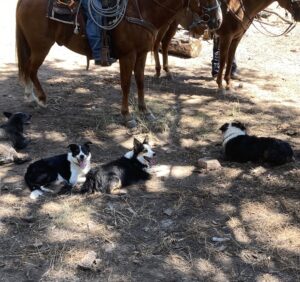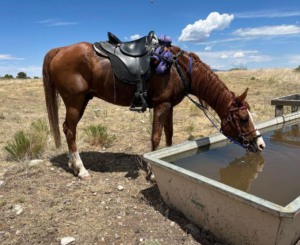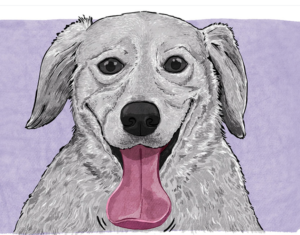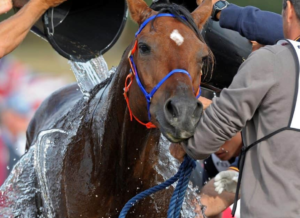
Dogs, horses, and humans resting during a recent cattle drive.
It’s hot as heck! But we still want to get out there with our four-hooved and four-pawed compadres.
You’ll find LOTS of advice from professionals and non-professionals on scores of sites, shows, podcasts, and social platforms. Here’s our take in a concise yet summary post.
Please note that we are not veterinarians or professionals. Our recommendations are informed but informal.
We spoke with Sophie Barton, a PhD student studying dogs at Harvard University, and Joanna Zattiero, an accomplished endurance rider and trainer. Find general guidelines below and see links for more information. Stay safe out there.
Recommendations for dogs, horses, and people:
Conditioning and acclimatization

Zattiero’s horse, Lionel, on a recent endurance ride.
If you and your animals are exercising in the heat, it’s crucial to condition yourselves to the hot-weather challenges gradually. Lack of fitness and obesity, for instance, can be strong determinants in dogs’ inability to tolerate heat. Ditto with humans and horses.
While Arabians, with their lanky build and “thin skin” are best adapted to long, hot rides, any Arabian still needs to get used to the outings with months of rides already logged.
Even with a good level of fitness, heavier, colder-blooded horses (draft breeds) struggle more with heat dissipation. This is an example of the Bergmann Rule, which observes that the smaller the animal (humans included), the higher the ratio of its skin surface to its volume, allowing it to lose heat quickly and cool faster. In contrast, bigger, stockier animals have a lower surface area-to-volume ratio. They retain heat more (which is optimal in cold climates).
 For dogs, writes Sophie: “Factors contributing to increased body temperature include ambient temperature, physical exertion and fitness level, hydration status, and relative humidity.”
For dogs, writes Sophie: “Factors contributing to increased body temperature include ambient temperature, physical exertion and fitness level, hydration status, and relative humidity.”
Check out this study on working dogs.
Check out this study on heat index and dogs.
Sophie learned this easy rule of thumb from sled dog trainers: “Add the temperature in Fahrenheit to the humidity percentage. If it exceeds 130, you should exercise with caution. If it exceeds 150, you probably shouldn’t exercise your dog.
“Another option is to look at the heat index table, while keeping in mind that dogs have lower temperature and humidity tolerances than humans.”
Hydration and electrolytes
Panting (for dogs) and sweating (for horses and humans) is the main mechanism for cooling. If there’s a lot of panting and sweating going on, there should be a lot of drinking, too. Water is best. But over time and miles, it will be important to consider electrolytes (which means salt, magnesium, and other vital ingredients). Some folks force it on their dogs and horses, giving them no choice in the matter with pill or paste, or only water mixed with electrolytes. If you decide to give electrolytes in this way, moderate dosages first as dogs and horses may get sick from too much. Other folks offer it as an option, one pail of water with electrolytes, one without them. (We prefer the latter strategy.)
 Don’t forget yourself!
Don’t forget yourself!
Again, water (not coffee or beer) is key. Over time, replacing electrolytes is essential. Drinking only water can lead to critical concerns like hyponatremia, when the sodium level in your blood becomes abnormally low.
Joanna particularly likes hydration drinks from Skratch Labs, which we like too. Use “besthorse25” to get 25 percent off.
Averting Trouble and Acting Quickly
If you’re out in the sun with your animals, pay attention to how you are all functioning or not functioning.
Signs of struggle in dogs, writes Sophie, include spade-shaped tongue, retracted ears, squinty eyes, panting, and shade seeking.
In horses, excessive sweating or lack of sweating, weakness or stumbling, heavy breathing, refusal to work, tenting of skin (along with pale mucous membranes, a quick sign of dehydration).
In us humans, thirst, sweating, irritability, dizziness, headache, and weakness.
Dogs, horses, and humans all respond to cool or cold water. Drink it and get in it.
Joanna told us riders carry grain scoops or cut-open, old detergent bottles so they can scoop water onto horses’ necks, backs, and legs during competitions. Dogs will need to get into livestock troughs, ponds, kiddie pools, or creeks to cool down. If you are away from any water source, carry extra water to douse your animals.
Check out this instructional PDF on heat stress and horses, by Dr. David Marlin.
One more thing! Don’t spend too much time on pavement or asphalt with your horses and dogs. Dr. Sheryl King notes that those surfaces can be 40-60 degrees hotter than air temperature. Read more here.
I’m heading to Gila Wilderness in Sept from central Texas. My mare WILL NOT drink on the road..I was not prepared a year ago when we did this trip, after two days and 15 hours, I unloaded a dehydrated mare. Fortunately she lives natural water and green grass, so the stream and irrigated sheep field (along w banamine and soaked alfalfa), turned her around. I’m prepping now for trip, insulated trailer, shade screens on windows, switching to alfalfa pellets to pack in. A friend told me anything will go for Horse Quencher. Not her. My next plan is to have carrots and apples cut up in cool water container, and offer those at gas stops. Maybe offer soaked hay as well. Any other suggestions?
Watermelon. Horses love it and it’s high in water content.
Many thanks for the suggestions, all important.
I’ve got older horses and dogs, nobody works hard except when they dash about pastures or the dogs run after Javalina (they always stop short before actually catching them)